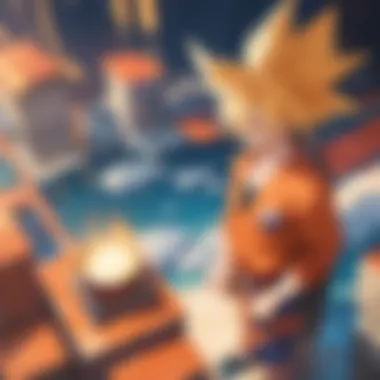Exploring the Dragon Ball Universe: A Comprehensive Guide


Intro
The Dragon Ball franchise has impacted anime and manga significantly since its inception. Its unique blend of storytelling, character development, and action sequences has captivated audiences worldwide. This guide aims to dissect various elements of the series, offering insights into its narrative richness and cultural significance.
Character Analysis
Overview of Character Development
Character evolution is a fundamental aspect of the Dragon Ball series. Each protagonist and antagonist has a well-defined journey, often reflecting personal growth and overcoming challenges. For instance, Goku's transformation from a naive, child-like fighter to a seasoned martial artist illustrates extensive character development. As he faces increasingly formidable adversaries, Goku’s character embodies perseverance and the relentless pursuit of strength.
On the other hand, Vegeta's character arc is equally compelling. Initially introduced as a ruthless villain, his character undergoes a gradual shift towards heroism. This transformation is a testament to effective writing; the nuanced layers added to his personality evoke empathy and offer a profound commentary on redemption.
Key Relationships and Dynamics
The relationships in Dragon Ball add depth to the narrative. Goku and Vegeta's rivalry serves as a cornerstone of the series. From animosity to mutual respect, their dynamic illustrates the complexities of competition and camaraderie. Moreover, the bond between Goku and his son Gohan presents themes of lineage and legacy. Goku’s mentorship helps Gohan discover his potential, showcasing the significance of familial ties in shaping character growth.
Another critical relationship is between Bulma and Goku. Bulma's intellect complements Goku's raw power, highlighting the importance of collaboration. Their friendship reflects the series’ overarching theme that strength comes from unity.
Thematic Exploration
Central Themes and Messages
Dragon Ball encompasses various themes, from friendship to the pursuit of power. The series emphasizes the importance of hard work and determination. Each character's growth stems from their dedication and resolve. This theme resonates with the audience, reinforcing the idea that anyone can achieve their goals through effort.
Additionally, the concept of good versus evil is prevalent throughout the series. Characters like Frieza and Cell embody pure malevolence, while Goku and his allies represent heroism. This conflict often raises moral questions about redemption and the nature of true strength.
Cultural Context and Influences
The cultural significance of Dragon Ball cannot be overstated. The series has not only shaped the anime landscape but also influenced global pop culture. Its success paved the way for subsequent shonen genre works, inspiring countless creators. The impact of Dragon Ball on storytelling, character design, and anime tropes is evident in many contemporary series.
Moreover, the show reflects a blend of Eastern philosophies and modern storytelling, drawing from martial arts traditions and shonen archetypes. This fusion appeals to a diverse audience, bridging cultural gaps.
"Dragon Ball is not just about fighting; it is about growth, friendships, and facing one's fears."
Prologue to Dragon Ball
The introduction to Dragon Ball plays a crucial role in understanding the franchise's vast universe. This section sets the stage by exploring the genesis of the series and its fundamental concepts that resonate throughout its many iterations. It provides insights into how Dragon Ball transformed the anime and manga landscape, influencing countless works that followed. By unpacking its origins and framework, readers will obtain a foundational grasp of the elements that contribute to the series' enduring appeal.
The Origins of Dragon Ball
The origins of Dragon Ball trace back to 1984 with Akira Toriyama, who introduced audiences to a world filled with martial arts, adventure, and surreal elements. The series was first serialized in Weekly Shōnen Jump, drawing inspiration from the classic Chinese novel Journey to the West. Toriyama's compelling storytelling and unique character designs captivated readers, leading to increasing popularity. Initially, the narrative focused on the adventures of a young warrior named Goku as he seeks out the mystical Dragon Balls, which grant the wishes of those who collect them.
Notably, the blend of humor and action created a distinct tone. The success of Dragon Ball eventually led to animated adaptations, merchandise, and spin-offs, solidifying its position in popular culture. Without understanding the origins, one cannot fully appreciate the complexities and growth of the universe that has unfolded over the decades.
The Conceptual Framework
The conceptual framework of Dragon Ball encompasses various themes such as friendship, rivalry, and self-improvement. These elements not only drive the character arcs but they also present moral lessons that resonate deeply with audiences. The series is structured around the classic hero's journey, featuring Goku's continual quest for strength and knowledge. Therefore, the themes of growth and transformation are dominant.


- Core Elements:
- The importance of training and discipline.
- The impact of relationships among characters, impacting their journeys.
- The cyclical nature of conflict and resolution push the narrative forward.
"In Dragon Ball, every battle isn't just physical; it's a test of one's character and ideals."
This conceptual underpinning has enabled the franchise to evolve beyond its origins. Darker themes have been introduced over time, reflecting changes in audience expectations and societal norms. Understanding these themes lays the groundwork for a comprehensive exploration of the later series, characters, and cultural ramifications.
Series Overview
The Series Overview section delves into the core iterations of the Dragon Ball franchise. Understanding each series is crucial for comprehending the evolution of its narrative and the development of its characters. This segment helps both fans and new audiences grasp the unique features and story arcs that define the entire Dragon Ball experience. Each series in the franchise introduces distinct elements that contribute to its legacy, making it important to explore them in detail.
Dragon Ball
Dragon Ball marks the inception of this expansive universe. Released in 1984, it introduces us to Son Goku, a young martial artist with remarkable abilities. The series is inspired by the classic Journey to the West, but it quickly evolves into its own story. It centers on Goku's quest for the Dragon Balls, which can grant wishes when gathered.
The show balances adventure and action while exploring themes such as friendship and determination. Iconic characters are introduced, including Bulma, Krillin, and Master Roshi. Importantly, Dragon Ball sets the tone for future iterations, laying foundational lore and character relationships that resonant throughout the franchise.
Dragon Ball Z
Following up on the original, Dragon Ball Z expands the scope of the series significantly. Premiering in 1989, it introduces more intense battles and heightened stakes. The narrative shifts to focus on Goku’s life as an adult and father, facing potent foes like Frieza and Cell. This series emphasizes growth, both in terms of character development and power scaling.
One significant element of Dragon Ball Z is the introduction of the Super Saiyan transformation. This moment captivated audiences and forever altered how battles were perceived in the series. The emotional depth found in the relationships, especially between Goku and Vegeta, adds layers to the plot, making it a pivotal chapter in the franchise.
Dragon Ball Super
After a lengthy hiatus, Dragon Ball Super debuted in 2015. This series rejuvenates the franchise with fresh narratives and characters. Goku and his companions face new challenges across multiverses, emphasizing battles beyond the traditional fight format. The introduction of powerful deities, such as Beerus and Whis, adds complexity to the lore.
The exploration of the Tournament of Power arc showcases not only epic conflicts but also themes of teamwork and resilience. The series also delves into the backstories of various characters, offering a richer understanding of their motivations and histories.
Dragon Ball GT
Dragon Ball GT, released in 1996, is often deemed separate from the main continuity. It does not follow Akira Toriyama's original manga, leading to diverse opinions among fans. In this series, Goku is transformed back into a child, and he embarks on a journey to gather Dragon Balls across the universe once more.
While some appreciate its unique direction, others criticize the lack of character development and coherence compared to its predecessors. Despite mixed reviews, Dragon Ball GT left a mark on the franchise, contributing to ongoing discussions about what defines a true Dragon Ball story.
Character Analysis
Character analysis is a foundational component of understanding the Dragon Ball franchise. Characters are the driving force of the narrative, providing emotional depth and thematic richness. In this section, we will explore several key characters, examining their journeys, relationships, and transformations. Through character analysis, we uncover essential themes and messages that resonate with audiences. This approach can enhance appreciation for the series and its intricate storytelling.
Goku: The Protagonist's Journey
Goku serves as the heart of the Dragon Ball series. His journey epitomizes the classic hero's path, one marked by determination, growth, and resilience. Beginning as a naïve child, Goku evolves into one of the most powerful fighters in the universe.
His journey is not solely about physical strength; it reflects a deep commitment to his friends and family. Goku's desire to protect others drives many plot points. His cheerful disposition masks a formidable warrior, embodying a contrasting theme of innocence and battle.
Goku's constant pursuit of improvement resonates with fans, inspiring them to embrace challenges in their own lives. His journey raises questions about what it means to be strong and how far one should go for self-improvement.
Vegeta: The Evolution of a Rival
Vegeta's character arc is complex and compelling. Initially introduced as a ruthless antagonist, his evolution into an anti-hero and eventually a key ally is striking. Vegeta's pride and rivalry with Goku fuel much of his development. His transformation from a villain to a protector exemplifies significant themes of redemption and growth.
Where Goku represents a humble approach to strength, Vegeta embodies the struggle for pride and acknowledgment. His character development is layered with personal struggles, such as his relationship with Bulma and the challenges of fatherhood. This transformation adds significant depth to the story, contrasting the implications of rivalry, jealousy, and the potential for change.
Vegeta's duality captivates audiences, making him a character many can relate to. The progression of his character is significant in showcasing maturity, vulnerability, and resilience.
Supporting Characters: Friends and Foes


The cast of supporting characters enriches the Dragon Ball narrative. Each character, from Krillin to Piccolo, brings unique traits that enhance the story. Their various strengths and weaknesses complement or challenge the main characters.
Supporting characters often provide comic relief, emotional support, or serve as pivotal plot devices. For instance, Piccolo's evolution from enemy to mentor offers an interesting dynamic. His wisdom and experience serve as a counterbalance to Goku's impulsiveness.
Moreover, characters like Frieza, Cell, and Buu highlight themes of ambition, power, and the darker aspects of strength. These antagonists present a counter-narrative to the heroes, making victories feel earned and significant.
The relationships among these characters create a tapestry of interactions that reflect the series' core themes of camaraderie and rivalry. Their collective journeys contribute to the overarching narrative, emphasizing the importance of community.
Female Characters: Representation in Dragon Ball
Female characters in Dragon Ball have often been overlooked, yet they carry substantial weight in the narrative. Characters like Bulma, Chi-Chi, and Videl showcase the multifaceted roles women can embody. Each female character adds depth and perspective to the story.
Bulma is a brilliant inventor and a key player in many arcs. Her technological contributions are vital for the heroes' success and betrayal.
Chi-Chi, on the other hand, embodies the challenges of motherhood, often bringing grounding elements to the often chaotic world of Dragon Ball.
Videl, initially introduced as a fierce fighter, also emphasizes the importance of compassion and personal growth.
While the series primarily focuses on male power, the development of these female characters indicates the potential for stronger representation.
Exploration of female roles reveals underlying themes of strength, resourcefulness, and emotional intelligence. Their presence points to a deeper understanding of gender dynamics within the franchise, inviting a more nuanced discussion.
"The characters in Dragon Ball, from Goku's innocence to Vegeta's pride, reflect aspects of human nature that resonate well beyond the series."
Character analysis in Dragon Ball allows fans to connect with these narratives on a profound level. By delving into the journeys of these characters, we illuminate the philosophical and moral questions posed throughout the franchise.
Themes and Motifs
The Dragon Ball series is rich in themes and motifs that resonate deeply with its audience. These elements do not only serve as narrative devices but also provide profound insights into human experiences. Themes like friendship, conflict, growth, and transformation are prevalent throughout the franchise. Understanding these themes allows one to appreciate the nuances of character interactions and story arcs. Furthermore, it reflects the moral dilemmas and emotional challenges that define the characters' journeys. This section explores the core themes of friendship and family, conflict and resolution, and growth and transformation, each contributing to the series' lasting impact.
Friendship and Family
Friendship is at the heart of Dragon Ball. The bond between Goku and his friends drives much of the plot's emotional weight. Characters like Krillin, Bulma, and Piccolo illustrate the value of camaraderie, showing that allies can help overcome insurmountable odds. This theme is especially pronounced in the series' early arcs, where Goku's growth is heavily influenced by his relationships with others.
Family connections also play a critical role. Goku's relationship with his son, Gohan, exhibits the balance between training for strength and nurturing for moral integrity. Other character dynamics, such as Vegeta's complex relationship with his family, offer layers to the narrative, showcasing the often contradictory motivations in pursuit of power and legacy.
The emphasis on friendship and family serves as a reminder that personal connections can lead to significant transformations, both in character arc and in plot development.
Conflict and Resolution
Conflict is an essential element in Dragon Ball, introducing challenges that characters must face. Whether it is battles against formidable foes like Frieza or internal struggles with personal demons, conflict drives the storyline forward. Each battle signifies more than mere physical confrontation; it reflects the inner conflicts characters experience, such as Goku's struggle with his Saiyan heritage or Vegeta's pursuit of self-acceptance.
Resolution often comes through victory in battle or personal growth from the journey itself. The way conflicts resolve varies; some end in triumph, while others lead to deeper understanding and acceptance of one's limitations. This complexity keeps audiences engaged and conveys a realistic sense of life’s challenges.
Growth and Transformation
The themes of growth and transformation are intrinsic to Dragon Ball. Characters evolve in strength, skill, and personality, reflecting their experiences and choices. Goku's journey from a naive child to a powerful warrior exemplifies this transformation. He exemplifies longevity in personal growth, showcasing that change is a constant process rather than a final destination.
Vegeta, initially an antagonist, equally embodies the transformation theme. His progression from arrogance to humility emphasizes redemption and the complexity of character development. Each transformation, whether it be physical through Super Saiyan forms or psychological through character introspection, contributes to the overall narrative arc.
Cultural Impact
The cultural impact of the Dragon Ball franchise is significant and multifaceted. It has served not just as a cornerstone in anime and manga, but also as a key player in the global pop culture landscape. This influence is evident in various domains, including the proliferation of similar art styles and storytelling techniques in anime. Moreover, Dragon Ball's reach extends beyond entertainment; it has become a symbol of resilience and perseverance for many of its fans.
Influence on Global Pop Culture
Dragon Ball has made an indelible mark on global pop culture that goes far beyond its original Japanese audience. The series has sparked interest in anime outside Japan, creating a bridge for other works to enter Western markets. Characters like Goku and Vegeta are now recognized worldwide. They have appeared in various forms of media, including video games, comic books, and merchandise, increasing their visibility.
The series also contributed to the development of the shonen genre. Its success has inspired a plethora of similar shows that aim to capture the balance of action, heroism, and moral dilemmas. Many franchises, including Naruto and One Piece, have cited Dragon Ball as an influence, evidencing its role as a foundational text in anime.
Importantly, Dragon Ball events like tournaments have transcended the narrative, inspiring real-world competitions and fan conventions where enthusiasts gather. These gatherings often celebrate not just the series but also the friendships and community formed around it.
Merchandising and Fan Engagement


The merchandising aspect of Dragon Ball is extensive and well-thought-out. It is not just about toys and collectibles; it encompasses a variety of products such as clothing, video games, and art books. This plethora of merchandise creates a virtual ecosystem where fans can engage with the franchise in different ways. This benefits both the franchise owners and the fans, providing avenues for deeper connection.
Fan engagement has evolved with the rise of social media. Platforms like Reddit and Facebook foster discussions among fans, enabling them to share theories, artwork, and memories. The active engagement from the community is a vital element in keeping Dragon Ball relevant. Fans often participate in cosplay, recreating iconic scenes and characters, bringing the franchise to life in a tangible way.
"Dragon Ball has formed a community that values creativity and connection, bridging fans across cultural lines."
As a result, the reach of Dragon Ball continues to expand, captivating new generations while maintaining the loyalty of long-time fans. The enduring popularity of Dragon Ball demonstrates how a franchise can shape cultural dialogues, establish fan communities, and influence the market.
Production Insights
The realm of Dragon Ball encompasses a multitude of elements that brought this franchise to life. Understanding the production insights is essential for grasping how the series has evolved over the years. This section delves into the fundamental aspects of creating a groundbreaking anime that continues to resonate with audiences globally. The production choices made during the development of the series shaped its narrative, artistic style, and overall reception.
Creation and Development
The creation of Dragon Ball is rooted in Akira Toriyama's imaginative storytelling and artistic vision. Initially serialized in Weekly Shōnen Jump in 1984, the series rapidly gained popularity. Toriyama's ability to blend humor, action, and character depth laid the groundwork for a rich narrative that captures the viewer's attention.
There were several key stages in the development process that contributed to Dragon Ball's unique identity:
- Manga Origins: The original manga served as the foundational element, providing the core story and characters. Toriyama's distinctive art style and character designs played a significant role in drawing audiences in.
- Adaptation to Anime: The transition from manga to anime required careful consideration of pacing and visual storytelling. The Toei Animation studio took on the task of bringing the still images to life, effectively capturing the action and emotions of characters.
- Narrative Expansion: New arcs and characters were introduced in the anime, which allowed the story to branch out in ways that the manga could not. This flexibility in storytelling has kept the series fresh and engaging for existing fans.
The collaborative efforts among writers, animators, and producers have been pivotal. Each aspect of production impacts not only the visual representation of the characters but also the narrative development that fans have come to expect.
Animation Techniques and Style
Animation techniques and style are among the most visible aspects of Dragon Ball. The series' distinct visual approach has set it apart in the crowded anime landscape. Toei Animation employed various methods to enhance the viewer's experience:
- Cel Animation: Early episodes of Dragon Ball utilized traditional cel animation. This technique involved painting characters on transparent cells, allowing for vibrant colors and dynamic action scenes.
- Dynamic Fight Sequences: The portrayal of fights became a hallmark of the franchise. Techniques like speed lines, impact frames, and slow-motion shots were employed to create a sense of urgency and excitement during battle sequences.
- Character Design: The character designs evolved throughout the series, reflecting both maturity and progression. Goku’s transformation from a child to a powerful warrior involved adjustments in his design that resonated with audiences.
- Visual Effects: As technology advanced, Toei incorporated computer-generated effects to enhance scenes, especially during energy attacks and large-scale battles. This integration has allowed for a more polished and engaging visual presentation.
The overall animation style is essential for conveying the story's themes and emotions. It reinforces the intensity of battles while providing moments of humor and character growth. These production choices outline not just a series but a cultural phenomenon that continues to evolve.
"Animation is not just about movement; it is about storytelling and emotion tied seamlessly with visuals."
By exploring the production insights, fans can appreciate the meticulous effort and creativity behind Dragon Ball. Understanding these aspects lends depth to the viewing experience and highlights why the series remains a staple in anime culture.
The Future of Dragon Ball
The future of Dragon Ball remains a topic of great intrigue for fans and creators alike. As a franchise that has made a significant impact over decades, its ongoing journey continues to capture attention. The strong foundation established through previous series sets a precedent for upcoming narratives. Moreover, knowing what is next allows fans to stay engaged and excited.
Upcoming Projects and Developments
Several upcoming projects indicate that Dragon Ball is not slowing down. Most notably, Dragon Ball Super: Super Hero, which focuses on a new story arc that dives deeper into character development and unique battles. This shift back to the origins of the franchise emphasizes Goku's quest but also introduces new characters who promise to add complexity to the storyline.
Furthermore, there are ongoing rumors of another anime series, speculated to continue from Dragon Ball Super. If these rumors materialize, we can expect to see various elements incorporated from past series, while also breaking new ground. Additionally, recent manga chapters have teased intriguing plots that could be adapted into animated form.
The prospect of new games also holds promise. Titles such as Dragon Ball Z: Kakarot showed how rich the lore can be, and further game adaptations may explore untold aspects of the universe.
"The expansion of the Dragon Ball universe through different media reflects its enduring popularity and the willingness of creators to innovate."
Evolving Fan Expectations
As the Dragon Ball franchise evolves, so do fan expectations. Fans today possess a different perspective compared to when the series first premiered. They seek innovation, not only in storytelling but also in character arcs and animation quality. With rising standards in the anime industry, viewers now demand more nuanced plots and deeper character explorations.
One key aspect is how the storytelling will reflect a modern audience's concerns and interests. For example, themes such as leadership, morality, and the consequences of power dynamics increasingly resonate with viewers. Fans expect narratives that challenge previous archetypes and leave them with thought-provoking questions.
Social media plays a role in this shift as well. Platforms like Reddit and Facebook enable direct communication between creators and fans. This interaction allows fans to express their desires, which producers may consider in future developments. It also fosters a community where shared theories and creative discussions flourish.















